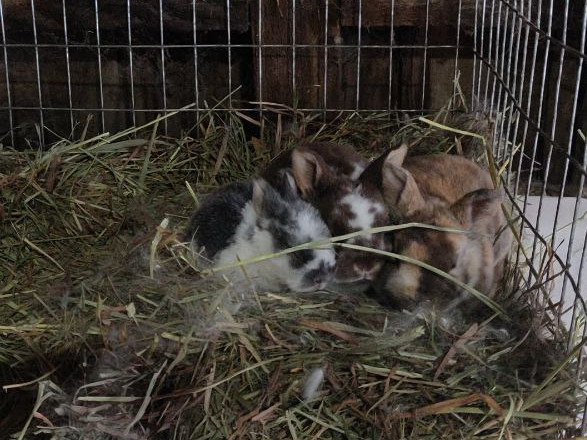Happy new year! Over the past month, a lot has been going on at the homestead. We have had new baby bunnies, lost our winter garden due to the crazy winds and cold snap, and we are even adding a new animal.
First off though, I want to talk about the rabbits, because I learned something new through some reading and actual experience. I was reading the book Raising Pastured Rabbits for Meat by Nichki Carangelo in December. She talks about a weird phenomenon where rabbits seem to go into something like a seasonal depression between Thanksgiving and New Years. In this state, they are more reluctant to breeding, and if they do breed, they are more prone to producing small and weak litters. When I read it, I assumed it was a strange rare occurrence, but having bred some of my rabbits at the end of November, I then experienced it first hand.
I had three rabbits due to kindle in December. All three of them were first time moms, so that could have attributed to the results. But when it was time to kindle, the first doe only had four kits. One was dead when I found it, and one ended up being a runt that didn't make it despite me getting it extra feedings with its mom. The second and third does each only gave birth to a single baby, and both were dead when I found them. So, it was a pretty sad thing to find when walking into the barn.
However, there is good news too. First off, in trying to help the runt in the first litter survive, I got to try out something new. I had to remove the runt and the mother from their cage, and then keep the mother still while the runt crawled under her and got in the extra feeding. At first, when the mom was more nervous, I actually held her up with one hand and held the runt directly to a teet with the other. Over time, the mother got more comfortable and actually preferred me petting her to calm her down while the runt nursed.
The second good thing that came out of it is that I finally got a harlequin rex rabbit! This is a gene that I have been working to produce in my rabbitry, and now I have one. If it is a boy, I'll be able to produce a lot more as well once he reaches maturity. The harlequin is a chocolate harlequin and has some great checkered markings on his face and ears.
Of course, there was that massive cold snap as well. That actually hit right after the litter with the harlequin and the runt was born. Another technique I tried for the first time during the cold was kit-shelving. This is when you remove the nesting box, kits and all, from the cage to keep them warm. Then you bring them out twice a day (12 hours apart) and put them back in the cage so the mother can feed them. This worked really well while it was super cold, and I was surprised that their mom jumped right into the nestbox every time for a feeding.
And finally, our new addition to the homestead. We are getting quail! I have raised quail before, and they are a great easy addition to any homestead. They produce tons of eggs, they reach maturity so quickly, and they are a lot quieter than chickens. I ordered hatching eggs from Sadie-Girl Farm and I got two different kinds. I have the Jumbo Coturnix Quail and the Celadon Coturnix Quail.
If you don't know what celadon is, it is a rare gene found in quail that causes all of their eggs to come out as a light blue color, often with brown speckles. And the reason I got them from Sadie-Girl Farm is because they managed to produce "true" celadon layers, which is even more rare. A "true" layer means that eggs hatched from their celadon eggs will only produce more celadon egg layers. This is something that only a handful of quail breeders have achieved in the US. So, if you're looking for quail eggs or chicks around Lebanon, PA, keep an eye on our Shop for updates.
That's all for this month. Happy homesteading!





